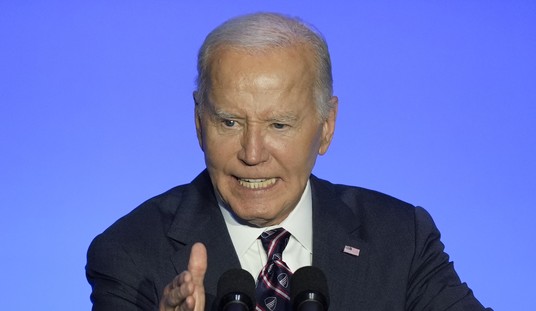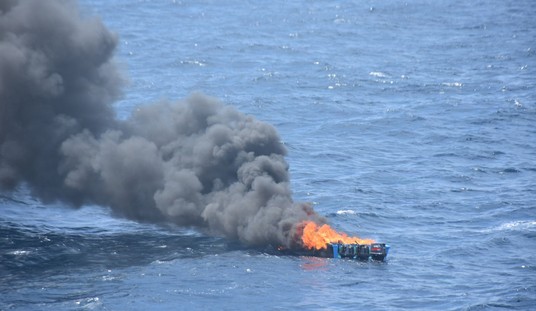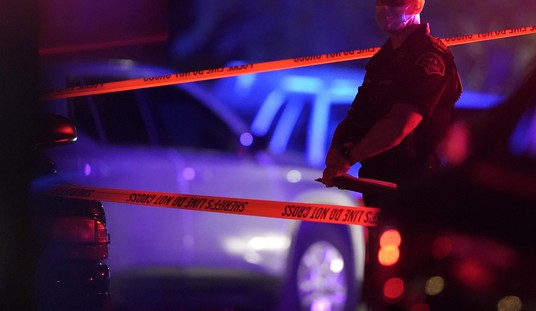
FILE – In this July 3, 1988 file photo, the crew of the USS Vincennes stands at attention to salute the USS Samuel B. Roberts which leaves the Persian Gulf. In 1988, the USS Samuel B. Roberts struck a mine and nearly sank. That sparked a daylong naval battle between Iran and the U.S. in which American forces attacked two Iranian oil rigs and sank or damaged six Iranian vessels. A few months later, the USS Vincennes in the Strait of Hormuz mistook an Iran Air flight heading to Dubai for an attacking fighter jet, shooting down the plane and killing all 290 people onboard. (AP Photo/Greg English, File)
Remember the USS Vincennes shooting down that Iranian airliner at the tail end of the Iran-Iraq War in 1988? Here’s an overview reminder:
Following the execution of Operation Praying Mantis on 18 April 1988, President Ronald Reagan gave U.S. Navy ships authority to engage Iranian warships that were in the act of attacking neutral merchant ships in the Arabian Gulf. This was an even more aggressive expansion of the previous rules of engagement, which only allowed U.S. Navy ships to aggressively maneuver to deter a potential Iranian attack on neutral shipping, but to fire only in self-defense or perception of Iranian hostile intent toward a U.S. Navy ship. U.S. Navy ships were still barred from taking retaliatory action against an attack on neutral shipping that had already occurred. The U.S. Navy also increased its force levels inside the Strait of Hormuz.
On 2 July 1988, at 0947, Iran Air Flight 655, an Airbus A300, took off 27 minutes late on a regularly scheduled flight (every Sunday and Tuesday from Bandar Abbas, a dual-use military and civilian airport) to Dubai— normally a short 30-minute flight. The pilot, Moshe Rezaian, was very experienced on this particular route. The flight was slightly off center, but still well-within the published flight corridor, Amber 59. Rezaian had no idea a surface action was going on directly under his flight path. Although Flight 655 was detected by Vincennes’s radar shortly after takeoff, the cruiser also detected a Mode II (military) identification, friend or foe (IFF) reading, most likely from an F-14 on the ground at Bandar Abbas. The operator mistakenly correlated the Mode II signal with the aircraft taking off rather than with the plane on the ground. The Aegis detected Flight 655’s Mode III (civilian) IFF transponder soon after take-off, but Vincennes’s anti-air warfare coordinator accepted the Mode II correlation as valid since Iranian military aircraft were known to transmit both Mode II and Mode III IFF.
After repeated warnings—seven on military air distress and three on international air distress, but none on air traffic control frequencies—and the contact approaching to within 10 miles, Rogers initiated the sequence of orders to fire. Two SM-2MR missiles were fired and two hit, one in the wing, the other the tail. The plane broke up in flight, and bodies fell from the sky. It wasn’t long before Dubai tower initiated queries for the missing aircraft, and the IRGCN speedboats were directed by higher authority to break off the engagement with Vincennes and commence a search and rescue mission, which was futile.
The investigation concluded that “Based on the information used by the CO in making his decision, the short time available to him in which to make his decision, and his personal belief that his ship and USS Montgomery were being threatened, he acted in a prudent manner.”
The Iranians railed at the US for years thereafter, even though the investigation clearly showed that the shootdown was accidental, with the situation exacerbated by IRGN-Navy actions ongoing nearly concurrently as noted above. The USS Vincennes misidentified the Iranian Airliner and shot it down. Huge tragedy.
Now compare the US response to that tragedy with what has transpired so far with the apparent shoot-down of Ukrainian flight 752 by an Iranian surface-to-air missile on Wednesday. The US responded to the Vincennes incident with a full admission within days followed by a full investigation and an apology that included reparations.
Now let’s look at Ukrainian Flight 752. The Iranians engaged in terrorism by enabling Iranian-backed militias to attach the US embassy in Baghdad. The US responded with a drone attack that killed the planners, IRGC-Quds Force commander Qassem Soleimani and Kata’ib Hezbollah founder and leader Abu Mahdi al-Muhandis. The Iranians then launched 15 short-range ballistic missiles at bases in Iraq in a retaliatory strike in which no lives were lost, despite Iranian-controlled media broadcasting fake news claiming hundreds of casualties.
At nearly the same time as those missile launches, Ukrainian Flight 752 crashed shortly after takeoff from Tehran Imam Khomeini International Airport. The crash killed 82 Iranians, 63 Canadians, 11 Ukrainians, 10 Swedes, 4 Afghans, 3 Germans, and 3 British nationals. Rather than conducting an open investigation, the Iranians refused to provide the two black boxes to outside parties to be read – the flight data and cockpit voice recorders. They have denied that Flight 752 had been shot down, yet there are multiple media reports that the airliner was indeed shot down. Here is one.
The differences between the two events couldn’t be starker or clearer, so far. Iran’s response is what is to be expected from a pariah state that is the world’s foremost sponsor of terrorism. Will they do the right thing and own up to the real cause?
The end.
H/T: Harold Finch














Join the conversation as a VIP Member